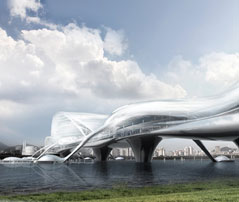
When it's fully operational in approximately 2020, wholly sustainable Masdar City is slated to have zero waste and zero carbon emissions; it will recycle most of its water and rely on solar energy and other renewable resources. Gas-guzzling cars are banned—replaced instead by podlike, battery-operated transit systems that travel underground. It's a visionary template for the world of tomorrow.
While Masdar City may represent the future metropolis, its planners are hardly the world's only visionary urbanites. Across the globe, architects and social engineers are taking entirely unique approaches to redefine how cities function. And traveling to these visionary cities today gives you a taste of the world of tomorrow.
1. Seoul: Public Bridge
The sleek, sculptural Paik Nam June Media Bridge—connecting Seoul's Dang-Li power plant with the National Assembly Building—will be a multilevel marvel. Inside the solar-powered span you'll find gardens (sprinkled with harnessed rainwater), a library, museum, and stores. Pedestrians and cyclists can leisurely cross the car-free bridge, and boats can dock at the base. Oh, and since the span is named after the renowned Korean video artist, expect the bridge to serve as a canvas for art installations. Construction is tentatively scheduled to begin in 2012.
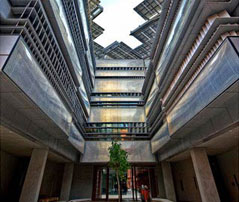
2. Masdar City, Abu Dhabi: Sustainability
Eco-warriors, meet Mecca: once completed, Masdar City promises to be the world's most sustainable urban locale. The city will be powered by solar and wind energy; recycle the majority of its wastewater; and try to reduce its waste to zero via unorthodox methods such as transforming biological waste into soil and fertilizer. A perimeter wall surrounding Masdar will keep desert winds at bay, while shaded streets combat the blazing sun. As for gas-guzzling cars, they're eighty-sixed from city limits (electric vehicles are allowed), replaced by mass transit and pod-like vehicles that travel underground. Some systems are already operational, but the city will come online fully in approximately 2020.
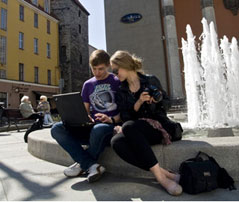
3. Tallinn, Estonia: Public Internet
You can check your e-mail and update your Facebook status from nearly everywhere in the Baltic nation's net-savvy capital, where the government deems free Internet to be a birthright. Thanks to the Tiigrihüppe ("Tiger Leap") initiative to wire the nation, every school is connected to the Internet; residents can vote in elections online; free Wi-Fi service blankets parks, trains, museums, cafés, and the airport. But don't spend all your time online: Tallinn's Old Town is a UNESCO World Heritage Site.
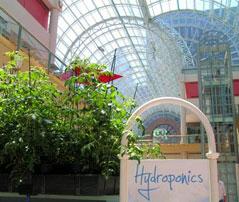
4. Cleveland: Urban Farming
While Cleveland's forlorn steel mills may be crumbling, the city's shopping malls are springing to life—plant life, that is. In the former Galleria at Erieview mall, a project dubbed Gardens Under Glass is helping the mall morph into a greenhouse. Sunlight streaming through the glassed-in atrium, as well as a hydroponics system, ensures the lush growth of vegetables such as spinach, lettuce, and tomatoes. Once harvested, the veggies are sold at the mall's weekly farmers' market.
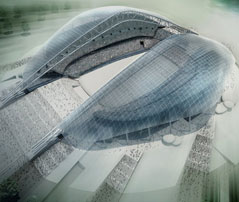
5. Sochi, Russia: Sports Stadium
In preparation for the 2014 Winter Olympics, Russia has designed the sweeping, sustainable Sochi Olympic Stadium to mimic a shell, thus bringing to mind the country's famous Fabergé eggs. To accomplish that, the stadium's walls and roof are wrapped in a semitransparent, crystalline skin that reflects sunlight shimmering off the nearby Black Sea and, at night, can be illuminated. Should Olympic events bore attendees, they can content themselves by soaking up gorgeous views of the Krasnaya Polyana mountains.
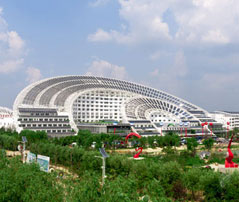
6. Dezhou, China: Energy Grid
Coal-crazed China may seem like an unlikely environmental booster, but it's betting on a green future in this northern Chinese city. Here, farmland and forest have been bulldozed to create an industrial zone dubbed the Solar Valley. The city is so committed to sun power that more than 80 percent of buildings have solar water heaters (Dezhou is the world's largest producer of the devices), streets are lit by solar lights, and luxury apartments—eco-friendly, of course—are outfitted with solar-heated pools.
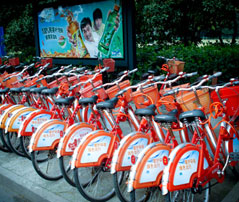
7. Hangzhou, China: Bike-Share Program
Historically, Beijing has been China's most bike-mad city, but Hangzhou—situated several hours northwest of Shanghai—has stolen the city's two-wheeled crown thanks to its far-reaching bicycle-sharing program. More than 50,000 bright-red bikes, equipped with baskets and bells, have been placed at numerous rental stations around Hangzhou. Borrowing a bike is simple: after acquiring a transportation card (it holds your rental funds), swipe it over a bicycle and you're free to pedal, well, freely—the first hour costs nothing.
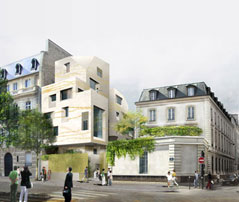
8. Paris: Public Housing
After decades of building bland, blocky social housing in its banlieues (the outskirts of a city), Paris has started commissioning cutting-edge architects to re-create public housing within the city proper. For example, the drab 17-story Tour Bois le Prêtre was retrofitted with balconies, and apartments were enlarged to maximize natural light. In the trendy Seventh Arrondissement, the modern Rue Saint Dominique Social Housing project stands apart with its Lego-like design, varied window openings, and exterior walls decorated with ornamental gold flakes. Leave it to the French to make public housing sexy.

9. Curitiba, Brazil: Public Transportation
In most metropolises, walking is faster than taking the crosstown public bus. Not so in Curitiba. In the 1960s, city planners examined their growing town and, to curtail congestion, implemented a comprehensive public-transportation scheme: Bus Rapid Transit. To speed up loading of the long, centipede-like buses, passengers—more than 80 percent of the population—pay low-cost fares beforehand (about 40 cents a ride, with unlimited transfers). The frequently arriving fleet speeds down dedicated streets unimpeded. It's often cited as the ideal public transport system.
See More of the World's Most Visionary Cities
http://travel.yahoo.com/p-interests-37533159

Tidak ada komentar:
Posting Komentar